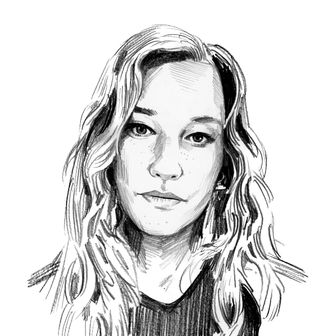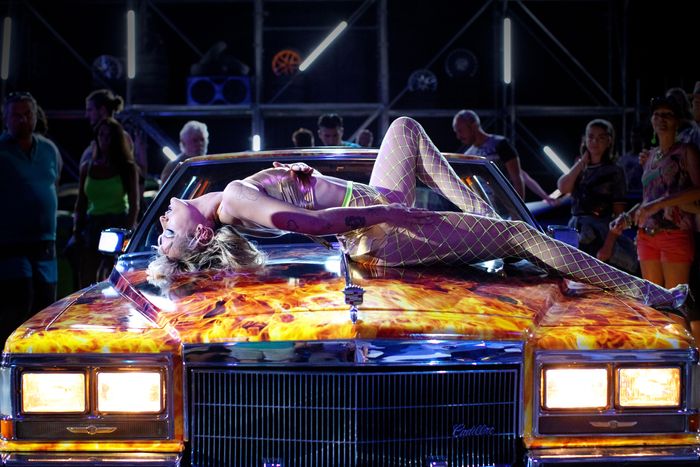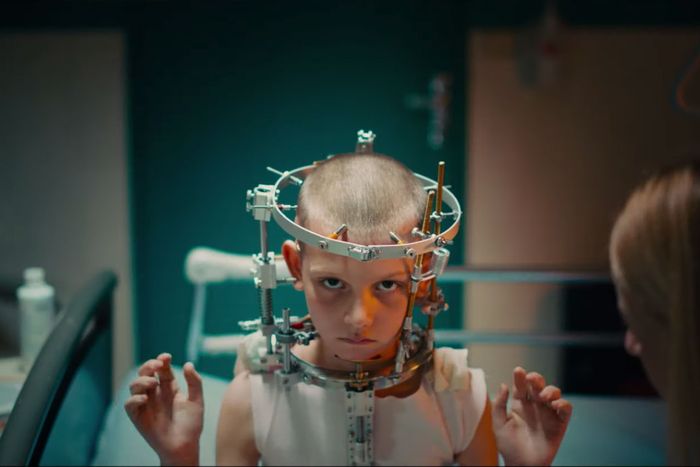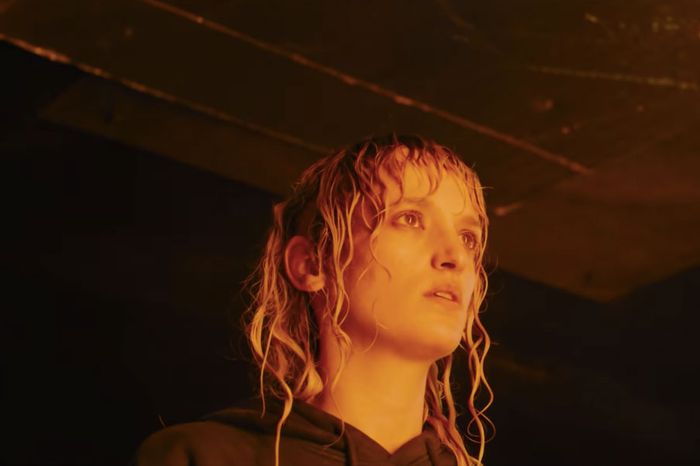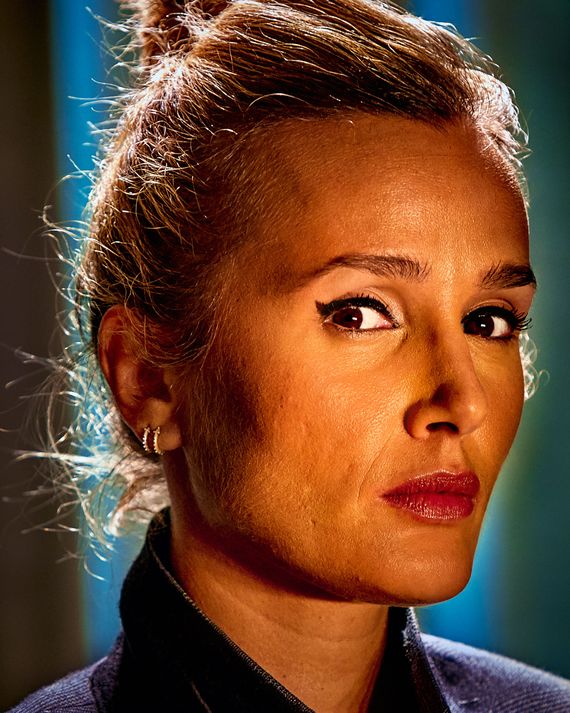
Julia Ducournau is telling me a horror story. A true one. The two of us are walking through MoMA on a crisp fall Friday afternoon, in part because it’s one of the Parisian writer-director’s favorite spots to visit when she comes to New York City and in part because the museum happens to be putting on an exhibit called “Automania,” which could be an alternate title for her Cannes Palme d’Or–winning, paradigm-smashing, car-fucking second feature, Titane. Despite having woken up at 4:30 a.m. and flown here from a film festival in Texas, Ducournau, 37, looks soigné: pleated black Prada skirt, black leather Chanel jacket, iridescent-purple Issey Miyake tote bag, matched with scuffed white Adidas sneakers and the remnants of a late-summer tan. She’s five-foot-nine but gives off the distinct impression that she is six-foot-nine. She warns me that she can’t stay inside the museum chatting for too long without a break. “It’s not because I like fresh air or anything. I don’t give a shit about that,” she says. “But I like smoking.”
Back to the scary story, which is not about an adolescent whose skin starts shedding like a snake’s (that would be the plot of her 2011 debut short, Junior), a bloodthirsty young cannibal making her way in veterinary school (her 2016 movie, Raw), or a female serial killer with a metal plate in her head who has sex with cars (that’s Titane). Unlike her horrifying, cathartic, and wickedly hilarious films — watching them is like plunging your brain into an ice bath, then strapping it into a race car and driving it off a cliff — this particular story is about Ducournau herself. After the surprising success of Raw — a coming-of-age film that made some people faint when it screened in Toronto — she was determined to write an even better feature, smarter and weirder than her first. But the ideas wouldn’t come, she says. Every single day for an entire year, she woke up, sat down in front of her computer, and wrote absolutely nothing.
“When I say a year, it’s not like a year and I’m going on holidays,” she says. “It’s a year, every morning, you wake up, you take a shower, you dress, and you sit in front of your computer all day and nothing comes.” On the rare occasion that she did write a sentence, she immediately deleted it, disgusted. The specter of expectations haunted her. Ducournau tells me several times that she hates when people reduce her films, which she sees as complex, genre-hopping creatures, to mere body horror. “People wanted Raw 2 — like Raw but more gory,” she says, rolling her eyes. “I knew I was not going to yield to them, and at the same time, you can’t help being afraid that if you don’t give the people what they want, then they’re not going to like it.” When I ask her why she didn’t take a break, she looks at me like I have seven heads, something she does often as we stroll through the museum. “There is no way I can actually enjoy my life if I think I’ll never be able to do something ever again,” she says. “The only way was to try.”
Ducournau has been driven by an obsessive intensity of focus for as long as she can remember. She grew up in an apartment next to the Moulin Rouge with a dermatologist father and a gynecologist mother who casually talked about their patients at the dinner table, sparking her lifelong fascination with the human body: its grossness, its ability to morph and change, its inevitable decay. “I remember I was in my bath at age 5 and I realized I was going to die,” she says. Once, at a dinner party when she was 6, her cinephile parents plopped her in front of the TV, and she found herself watching The Texas Chain Saw Massacre. “I didn’t have a clue what was happening,” she says. “I accepted it as a kid so absolutely.”
When Ducournau wasn’t calmly watching cannibals chainsaw people to death, she was writing poetry and prose and short stories. She read too, Edgar Allan Poe and Mary Shelley, and watched David Cronenberg and David Lynch, reveling in their characters — the monsters. “You always feel like a monster when you’re a teenager. You stink. You have weird hair,” she says. “The element of monstrosity in teenage years is incredibly enduring and real.” When she was 16, a French publishing house caught wind of her poetry and asked her to write a full book. “I froze and I couldn’t,” she says. “I didn’t know if I could do more than what I had already done. And so I didn’t get published. And then I lost poetry. It’s like everything: You have to work to be good. It’s not like some biblical illumination falling on you.”
So she worked. She studied English literature and philosophy at the Sorbonne, then got into La Fémis, “the most famous film school in France,” to study screenwriting. By 20, she says, she knew she was going to become a filmmaker. She dismisses her first shorts as “so bad,” but smiles widely as she describes an early 16-mm. film she wrote and directed that sees a girl breaking up with her boyfriend at a bar, then suddenly picking up her stool and “beating the shit out of him, with blood everywhere.” When I point out the familiar themes in her work (furious women, blood everywhere), she nods. “I think that all directors make the same thing over and over again,” she says. “Someone once said that making movies is like looking at a diamond, every time through a different facet, through a different side of the diamond. And I think it’s really true.”
Ducournau sees her films as part of a “continuous gesture,” one that sees her trying to “gauge our humanity and be more precise about what it means” by regularly plumbing its grotesque, filthy depths. Her characters often struggle with a stomach-turning skin condition: a full-body rash, flesh peeling back from the bone, total bodily exuviation. “My films are layers,” she says, “that I leave behind to get to the next skin.”
Despite the crazed vehicular lust of her Titane protagonist, Ducournau does not drive. In fact, she doesn’t give a shit about cars. (That aspect of the film is “obviously symbolic,” she says.) She strolls indifferently past the museum’s displays of vintage Citroëns and Volkswagens. We stop and start instead at sculptor Lynda Benglis’s coils of sludgelike metal lying coolly on the ground like people who have turned to stone and melted. A gaping canvas-and-steel piece by Lee Bontecou that looks like the abyss itself stops her cold.
Our conversation comes around to her post–film-school days, when she cast the then-unknown 12-year-old Garance Marillier as the oozing Justine in Junior. It went on to premiere at Cannes’s Critics’ Week and won the festival’s Petit Rail d’Or for Best Short Film. Naturally, the early affirmation of Ducournau’s talent terrified her. “I distinctly remember thinking, Oh my God, I’m going to be that one person who peaked with a short,” she says.
But in 2012 she made a French TV movie called Mange, which followed an ex-bulimic seeking revenge on her college bully. Ducournau is blasé about it, and it has since disappeared from the public record; soon thereafter, she put everything she had into writing and making Raw, in which she again cast Marillier as a young woman whose body begins to betray her as it strives toward its true form. Raised in a family of vegetarians, the innocent Justine is forced to eat raw rabbit kidney as a hazing ritual and soon finds herself craving human flesh — specifically that of her roommate, Adrien, who inspires Justine to chomp on her own arm during her first sexual experience, and of her sister, Alexia, whose disembodied pointer finger she digests after a spontaneous sororal bikini wax gone wrong. Much like Junior, Raw was a critical hit, winning the Fipresci Prize at Cannes and cementing Ducournau’s place in the pantheon of genre filmmakers to watch. When those couple of people fell ill at festival screenings, the marketing team, press, and theaters all latched on, handing out barf bags and gleefully calling it “the grossest movie of 2017.”
Ducournau was thrilled her strange little movie translated to a larger audience but disappointed by the conversation it spawned. She insists that she didn’t want to gratuitously shock anyone. She just wanted to use the concept of cannibalism as a prompt to urge her audience to question their humanity, to create empathy in the face of the ultimate taboo. It’s possible that her childhood immersion in medical terminology had misled her into thinking most people were comfortable staring human destruction directly in its half-eaten face. “You make something, you do it with your heart, and then people are prepared to throw up when they watch it,” she says, shaking her head. “You have all these people that say that they like your film and, at the same time, so many others have misunderstood it. Personally, I couldn’t help but put this on myself, thinking, Oh my God, maybe I should have expressed myself better.” She was particularly furious at France, which put the highest-possible rating restriction on the film. “I felt it was very unfair because there are, like, two scenes that are hard to watch in that film,” she says. “That’s bullcrap. It’s just another body. It’s just because it’s different that it’s disturbing.”
Ducournau and I pause again, this time in front of Yves Klein’s Blue Monochrome, a confrontational single-shade canvas. We have found ourselves in the middle of her scary story, the one about a woman who put her heart into one movie only to have it handed back to her half-broken and the consequent years of self-torment as she tried to write another one. “He spent a long time looking for that blue,” says Ducournau, referring to Klein’s painting. “He committed suicide, and some people say that it’s because of this blue.” I ask her if she means that the search drove him to death — Klein died of a heart attack, not of suicide, though he famously jumped off a building twice — or if it was the color itself. She looks at me like someone might look at a child who has just spilled food on themselves. “I think it’s more what the blue means.”
Ducournau finally defeated her post-Raw block when she realized how angry she was — “at everything that people were expecting of my next film, everything I was expecting about my next film,” she says. “I was angry at Raw in a way, because it was taking way too much space.” When she allowed herself to be enraged at her own little Frankenstein’s monster of a movie, she was able to release herself from its bloody grip. It was around this time that she also began to have graphic nightmares about giving birth to pieces of a car, one grisly bit of metal at a time. “I think the collision between this pure act of life and this material that is dead and cold on the floor was something that disturbed me,” she says, “and was also attractive to me.”
In Titane, Ducournau puts her lead, played by Agathe Rousselle and also named Alexia, on a crash course with disaster. She gets into a car accident at a young age and has titanium implanted in her skull; the doctor tells Alexia’s parents to “watch out” for any signs that the implant has affected her neurologically. Alexia grows up to become a psychopathic exotic dancer who has wild sex with automobiles and savagely murders people by plunging a metal hair pin into their brains. But she is uncharacteristically sloppy during the murder of a would-be love interest named — what else? — Justine (Marillier). (“There is a possibility that all of the Justines might be the same person, a mutation of Justines, and there is a possibility that they’re not the same person. But now Justine is dead.”) Alexia is forced to go on the lam, where she decides to impersonate the long-missing son (another Adrien) of a steroid-addicted, sweet-hearted firefighter named Vincent (played by Vincent Lindon). Nipples leak motor oil, killing sequences verge into dark humor, and violent self-mutilation abounds, but ultimately it’s a queer found-family story in which two despondent, lonely people dredge up in each other the last vestiges of hope and connection. It’s a story about unconditional love, which the filmmaker says is one of the hardest things for her to write about.
Ducournau knew her script was, well, demented. She had abandoned the three-act structure and shirked any logline that might have helped sell the movie (before release, the only accompanying description was a definition of the word “titanium”). “There was no strategy. I’m not going to do three acts. It doesn’t work for my film. I’m going to do exactly what I want,” she says. The script was picked up by Neon in 2019, and by last year, she was filming.
For her near-silent, scathing protagonist, Ducournau chose another unknown. She pored over Instagram and casting websites until she found Rousselle, an aspiring actress and model with no feature credits to her name. Rousselle’s prep began almost immediately: a year straight of learning to act via monologues from Twin Peaks, Killing Eve, and Network; boxing and dojo training; mainlining videos of actual psychopaths to achieve a “void in the eyes.” On set, she faced hours of makeup and prosthetics. “Basically, my body didn’t belong to me for two months of shooting,” Rousselle says. “It was really disturbing. I didn’t have time to just regroup and be Agathe again. So I had this kind of dissociated experience.” In an early scene, Alexia purposefully breaks her nose on the side of a sink. When I saw this moment at Cannes, several people in my screening jerked up from their seats and ran out of the theater. Ducournau laughs when I tell her this. “I knew that would happen,” she says. “You know why I am happy about this? Because you actually don’t see anything. You think you see something, but you don’t. When you anticipate something, somehow it makes it worse in your head.”
Director of photography Ruben Impens, who also worked on Raw, remembers everyone being stunned by Ducournau’s decisiveness and control on the set of Titane. He says she directs every scene as if she’s already editing it; she doesn’t do much coverage, which is rare, because she knows exactly how she wants the scene to look on film. (“Every time I make a shot, I try to make it like a painting,” is how Ducournau puts it.) “When I met her, there were sparks, and I could see maybe she was not the most easy person,” he says. “But somebody with a vision, an idea.” As Impens explains, Ducournau is “bored very quickly. She’s very smart, so when things don’t move or go fast enough …” He trails off and laughs. When I bring this up to Ducournau, who I have been desperately trying not to bore for 90 minutes, she smirks. “It’s not really that I’m bored,” she says. “It’s that I’m impatient.”
About halfway through filming, Ducournau realized the film she was making was even better than the one she had in her head. She had this epiphany during a scene in which Rousselle climbs atop a firetruck and does an erotic dance for her fellow firefighters, who have just been knocking into one another on the ground in a hypermasculine mosh pit. To Ducournau, the scene represents what she describes as her “queer vision of the world,” one that “had to transpire in my mise-en-scène with light, with angles. Not just the script. It’s also how you portray and deconstruct gender stereotypes.” (When I ask if she herself identifies as queer, she stops me with a bemused but stony gaze. “Who I am and what I am is absolutely irrelevant. Everything that counts is the art.”) Ducournau was so certain of its power that she shot it through only once. Impens vividly remembers the moment: “She said, ‘It’s perfect, let’s move on.’ Everybody was like, ‘Are you sure?’ ‘Of course I’m sure. Is it on camera? Great. Let’s move on.’”
The movie premiered at Cannes in July to almost unilateral raves, but it was still considered an underdog in terms of its chances of winning the Palme d’Or. Cronenberg’s Crash, perhaps one of the only other movies featuring sexual attraction to automobiles to premiere at the French festival, was famously denied the prize back in 1996 because Francis Ford Coppola was so scandalized. So when Cannes jury president Spike Lee accidentally announced Ducournau’s name at the beginning of his awards ceremony, both the audience and Ducournau were stunned. In her acceptance speech, which she’d written that same day on a public terrace, weeping, she thanked the audience for “letting the monsters in.”
Ducournau says the experience of making Titane helped her finally shed whatever was left of her self-doubt. She is already working on two new projects, one in France and one in the U.S. She won’t tell me anything about them, other than that she feels “a bit more ready to have fun” with her writing. “That doesn’t mean I’m going to do a comedy,” she says quickly. Writing, she admits, is still horrible in all the usual ways, but she’s able to see it now for what it is: “It’s a pain that is so visceral and vital. And somehow that questions the very reason you’re alive. It’s the best thing ever.”
As we walk out of MoMA, across an open bridge with glass walls on either side, Ducournau grabs my arm, looking temporarily vulnerable. Heights — one of her only fears. “I have horrible vertigo,” she says. “You have to help me.” I tell her it’s interesting that she’s scared of something as quotidian as heights but makes profoundly unsettling movies about people confronting death. She ponders this for a moment. “I think the vertigo maybe has to do with letting go and control.” She keeps her hold on my arm as we step on to the escalator, pressing shakily into me with no suggestions of self-consciousness. When we reach the bottom of the escalator, she instantly lets go, stands up straight, adjusts her messy bun, and looks intimidating again. “I’m going to tell you something very interesting,” she says, lowering her voice. “The only place I brave my fear is on set. If I have a very wide shot from high and want to crane or have to climb up a wall to catch an interesting angle — it’s not that I’m not scared.” You power through, I suggest. “Yes,” she says. “For me, my film is more important than if I die on set.”


